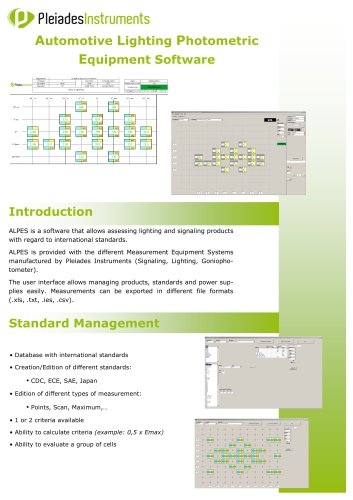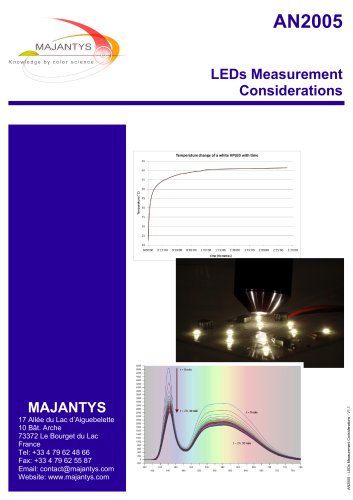
Catalog excerpts
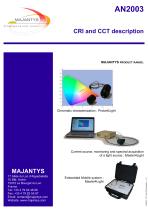
MAJANTYS PRODUCT RANGE. Current source, monitoring and spectral acquisition of a light source : Master4Light 17 Allée du Lac d’Aiguebelette 10 Bât. Arche 73372 Le Bourget du Lac France Tel: +33 4 79 62 48 66 Fax: +33 4 79 62 55 87 Email: contact@majantys.com Website: www.majantys.com Embedded Mobile system : Master4Light
Open the catalog to page 1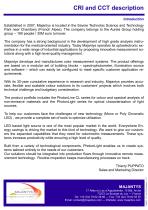
CRI and CCT description Introduction Established in 2007, Majantys is located in the Savoie Technolac Science and Technology Park near Chambery (French Alpes). The company belongs to the Aurela Group holding group – 180 people / 30M euro turnover. The company has a strong background in the development of high grade analysis instrumentation for the medical-oriented industry. Today Majantys operates its optoelectronic expertise in a wide range of industrial applications by proposing innovative measurement solutions along with a high level quality management. Majantys develops and manufactures...
Open the catalog to page 2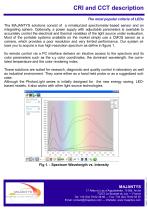
The most popular criteria ofLEDs The MAJANTYS solutions consist of a miniaturized spectrometer-based sensor and an integrating sphere. Optionally, a power supply with adjustable parameters is available to accurately control the electrical and thermal variables of the light source under evaluation. Most of the portable systems available on the market simply use a CMOS sensor as a camera, which provides a poor resolution and very limited performance. Our system al- lows you to acquire a true high resolution spectrum as define in figure 1. Its remote control via a PC interface delivers an...
Open the catalog to page 3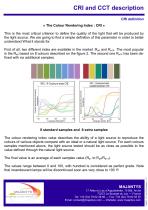
CRI and CCT description CRI definition « The Colour Rendering Index : CRI » This is the most critical criterion to define the quality of the light that will be produced by the light source. We are going to find a simple definition of this parameter in order to better understand What it stands for. First of all, two different index are available in the market :Ra8 and Ra14. The most popular is the Ra8 based on 8 colours described on the figure 2. The second one Ra14 has been defined with six additional samples. 8 standard samples and 6 extra samples The colour rendering index value describes...
Open the catalog to page 4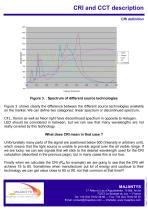
Figure 3. : Spectrum of different source technologies Figure 3. shows clearly the difference between the different source technologies available on the market. We can define two categories: linear spectrum or discontinued spectrum. CFL, Xenon as well as Neon light have discontinued spectrum in opposite to Halogen. LED should be considered in between, but we can see that many wavelengths are not really covered by this technology. What does CRI mean in that case ? Unfortunately many parts of the signal are positioned below 500 (Intensity in arbitrary unit), which means that the light source...
Open the catalog to page 5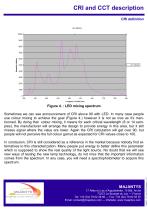
Figure 4. : LED mixing spectrum Sometimes we can see announcement of CRI above 90 with LED. In many case people use colour mixing to achieve the goal (Figure 4.) however it is not as nice as it’s mentionned. By doing that colour mixing, it means for each critical wavelength (8 or 14 samples), the manufacturer will arrange the design to provide energy in this area, but it still misses signal where the value are lower. Again the CRI calculation will get over 90, but people will not perceive the full colour gamut as expected for CRI values close to 100. MAJANTYS 17 Allée du Lac d’Aiguebelette,...
Open the catalog to page 6
Figure 5. : All range of colour temperature « CCT : Colour Temperature » The colour temperature is conventionally stated in units of absolute temperature, Kelvin (K). The color temperature of a light source is the temperature of an ideal black-body radiator that radiates light of comparable hue to that light source. Note that this makes sense only for the “white” emissive light source. As you can see in figure 5. the white source comes from a very “warm” to a “cool” white. Cited together, the CRI and CCT give a numerical estimate of what reference (ideal) light source best approximates a...
Open the catalog to page 7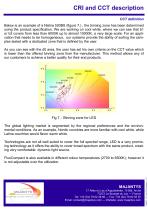
CRI and CCT description CCT definition Below is an example of a Nishia 500BS (figure 7.) , the binning zone has been determined using the product specification. We are working on cool white, where we can see that b1 or b2 covers from less than 6000K up to almost 10000K, a very large scale. For an application that needs to be homogeneous, our systems provide the ability of sorting the samples tested with a dedicated zone that is defined by the user. As you can see with the d0 area, the user has set his own criteria on the CCT value which is lower than the offered binning zone from the...
Open the catalog to page 8All Pleiades Instruments catalogs and technical brochures
-
Cutoff Measurement System
12 Pages
-
ALPES
2 Pages
-
MSU series - Datasheet
8 Pages
-
Probe4Light - Datasheet
11 Pages
-
Multicells systems
16 Pages
-
Goniophotometer
16 Pages
-
Company Profile
6 Pages
-
Mesure de sources lumineuses
5 Pages
-
LabVIEW API
2 Pages



